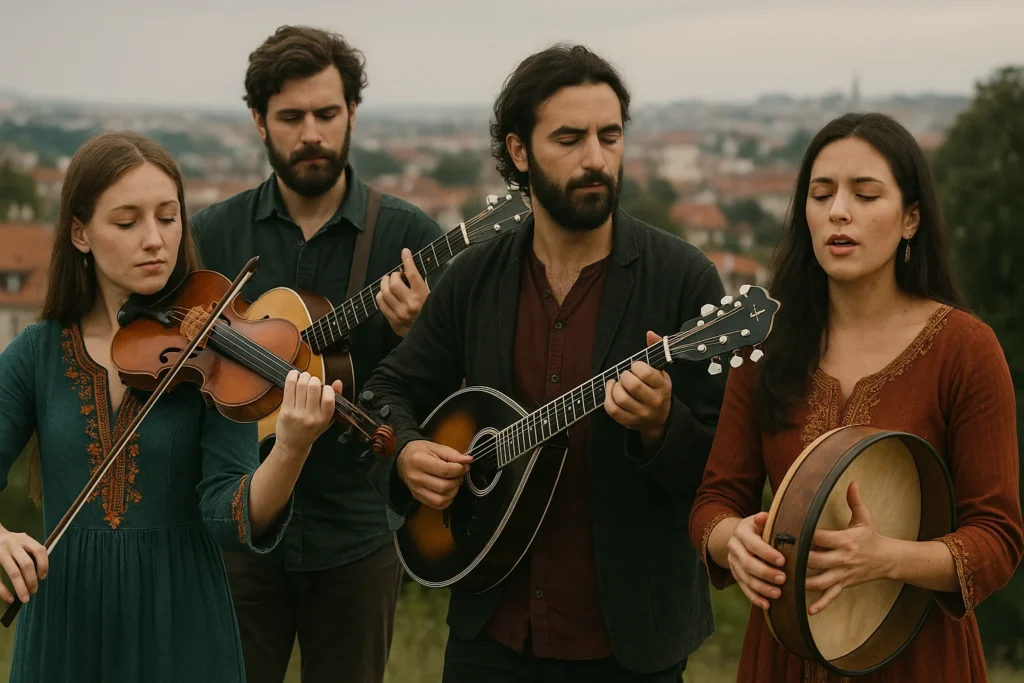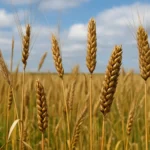Introduction: The Unexpected Revival of Ancient Sounds in a Digital Age
In a world increasingly dominated by the ephemeral beats of electronic music and the polished, often sterile perfection of auto-tuned vocals, an extraordinary and deeply resonant phenomenon is unfolding: folk music is experiencing a powerful, global resurgence. This isn’t just a nostalgic flicker; it’s a full-blown cultural renaissance. From the windswept, mist-shrouded hills of Ireland to the sun-drenched, bustling streets of Colombia, the soulful echoes of traditional melodies are being rediscovered, artfully reimagined, and shared across continents like never before, weaving a rich tapestry of sound that connects past, present, and future.
The indicators of this vibrant comeback are compelling. Modern-day conduits of sound – the omnipresent streaming platforms – are reporting a staggering 60% surge in folk music playlist engagement since 2023. This isn’t just a fleeting trend; it points to a profound shift in listener preferences. Concurrently, dedicated festivals celebrating regional and indigenous sounds are not only drawing massive crowds but consistently selling out worldwide, indicating a deep hunger for authentic cultural experiences. But why this sudden, almost primal gravitation toward sounds that, for decades, seemed relegated to the annals of history or niche cultural enclaves? In an era saturated with digital noise, hyper-connectivity, and the relentless pursuit of the next big thing, humanity is yearning for something more substantial. People are seeking authenticity, genuine human connection, and a deeper resonance with their own identity and heritage. Folk music, with its unvarnished storytelling, raw emotionality, and intrinsic cultural roots, is not merely answering this call; it is embodying it, becoming a comforting antidote to the often-impersonal digital landscape.
This burgeoning movement transcends mere nostalgia. It’s a dynamic, living force, propelled by diverse motivations. Young artists, unbound by conventional genre limitations, are ingeniously weaving ancient instruments into contemporary soundscapes, creating exciting fusions that defy categorization. Activists are harnessing the inherent power of folk songs to articulate and address pressing global issues, transforming timeless melodies into potent messages of change and solidarity. And critically, organizations like UNESCO are actively engaging in the crucial work of safeguarding endangered musical traditions, recognizing their invaluable contribution to humanity’s shared heritage and ensuring their legacy for future generations. Join us as we embark on a journey through this remarkable transformation, exploring how folk music is not just surviving, but powerfully reclaiming its vital and irreplaceable place in the global soundscape.
Chapter 1: The Digital Lifeline for Folk Music – Bridging Eras with Bytes
Streaming Platforms: Unexpected Guardians of Ancient Melodies
Just a mere decade ago, many invaluable folk traditions teetered precariously on the brink of obscurity, facing the very real threat of fading into the forgotten echoes of time. The dedicated guardians of these traditions, often elders within their communities, struggled to find an audience beyond their immediate geographical boundaries, making the transmission of knowledge to younger generations a significant challenge. Yet, in a fascinating and almost ironic twist of fate, the very behemoths of the digital age – platforms like Spotify, YouTube, and Bandcamp – have emerged as unlikely, yet profoundly effective, allies. These digital empires, once perceived by some as accelerators of the globalization and homogenization of music, are now inadvertently acting as powerful conduits for cultural preservation and dissemination. Their sophisticated algorithms, initially designed to curate and recommend mainstream hits, now seamlessly place the ethereal beauty of Mongolian throat singing alongside indie folk playlists, or the intricate melodies of a Japanese koto next to contemporary acoustic tracks. This innovative cross-pollination effortlessly introduces ancient sounds to entirely new, unsuspecting audiences, sparking curiosity and appreciation in a way previously unimaginable.
The data underscores this profound impact. Spotify’s meticulously curated “Global Folk” playlist has witnessed an astounding 200% increase in listens since 2022, a clear indicator of a burgeoning appetite for diverse traditional sounds from every corner of the planet. Furthermore, the short-form video phenomenon of TikTok, with its rapid viral trends, has inadvertently become a global stage for unexpected instruments. We’ve seen intricate fingerwork on the Irish bouzouki captivate millions, while the resonant, soulful cries of the Indian sarangi have provided the soundtrack to countless user-generated videos, sparking curiosity and inspiring new learners. This unprecedented accessibility has radically democratized music creation and dissemination. Independent artists, once dependent on the often-restrictive gatekeepers of major record labels, are now bypassing these traditional structures entirely. They are skillfully leveraging crowdfunding platforms to finance the meticulous recording of traditional albums, proving that collective passion and community support can be a far more powerful force than corporate backing alone. This digital ecosystem fosters a sense of direct connection between artists and their audiences, building dedicated communities around niche genres.
The Transformative Power of Social Media in the Folk Revival
The youth, ever at the forefront of technological adoption and creative expression, are leading the charge on social media platforms. Instagram and TikTok have evolved into vibrant, dynamic stages where young musicians proudly showcase not only their talent but also their deep connection to traditional folk instruments, often infusing them with an undeniable modern flair. Imagine a Finnish kantele player, their fingers dancing across the ancient strings, deftly looping their mesmerizing melodic patterns over a contemporary electronic beat, creating a hypnotic fusion that transcends conventional genre boundaries. Or picture a Peruvian charango artist, their nimble fingers producing intricate string work, collaborating seamlessly with hip-hop producers, their earthy rhythms providing a rich, soulful counterpoint to urban beats. These audacious collaborations are not just novelties; they are vital bridges, connecting disparate musical worlds and proving that tradition is not static but a living, breathing entity capable of exhilarating new expressions.
Crucially, this digital renaissance extends far beyond mere entertainment; at its heart, it is an act of profound cultural preservation. Consider this truly inspiring scenario: a 17-year-old in a bustling Brazilian city, captivated by a YouTube tutorial, diligently learns to play the berimbau, an instrument deeply rooted in Afro-Brazilian heritage, a symbol of capoeira and resistance. In that seemingly simple act, an entire tradition, often passed down orally through generations within specific communities, gains a fresh, vibrant lease on life, carried forward by a new pair of hands and a passionate young spirit. The digital realm has effectively shrunk the world, dismantling geographical barriers and allowing cultural knowledge to flow freely, ensuring that ancient melodies continue to resonate, evolve, and inspire for centuries to come. This global exchange of musical ideas not only preserves individual traditions but also enriches the global soundscape, fostering a deeper understanding and appreciation of diverse cultures.
Chapter 2: Folk Festivals—Where the Past Meets the Present in Grand Celebrations
Ireland’s Fleadh Cheoil: A Rhythmic Heartbeat of Celtic Soul
Every summer, a magical transformation sweeps across various towns in Ireland as they prepare to host the venerable Fleadh Cheoil. This isn’t merely a festival in the conventional sense; it’s a living, breathing museum of music, a vibrant testament to Ireland’s rich cultural heritage. The very air vibrates with the soulful sounds of fiddles, the rhythmic, percussive thrum of bodhráns, and the joyous, nimble trills of tin whistles. Thousands gather – not just as passive spectators admiring a performance, but as active participants, united by a shared, almost genetic love for traditional Irish music. Here, the concept of “playing together” transcends mere performance; it’s a deep communal experience, a powerful bond forged through shared melodies, impromptu sessions in pubs, and spontaneous dances in the streets. The Fleadh Cheoil embodies the spirit of céilí, a gathering where music, dance, and storytelling intertwine.
What’s particularly compelling about the modern Fleadh Cheoil is its dynamism and forward-looking spirit. While undeniably steeped in centuries of tradition, it is by no means static or confined to the past. Young musicians, brimming with creative energy and an adventurous spirit, are fearlessly mixing traditional jigs and reels with pulsating techno beats, creating electrifying fusions that defy expectations. This audacious blend is not seen as a dilution of tradition but rather an evolution, a testament to the enduring adaptability of Irish folk music. It powerfully proves that folk music is not a relic confined to dusty archives but a vibrant, evolving art form capable of exhilarating new expressions, attracting new audiences while honoring its roots.
India’s Rajasthan International Folk Festival: A Desert Symphony of Unity
As the golden sun begins its majestic descent over the ancient city of Jodhpur, painting the sprawling Thar Desert dunes in hues of orange and gold, the Rajasthan International Folk Festival (RIFF) awakens. This extraordinary annual event, set against the backdrop of the magnificent Mehrangarh Fort, is a living tapestry woven from diverse sounds and movements, a convergence of ancient and contemporary. RIFF masterfully brings together the hypnotic voices of Manganiyar singers, whose melodies carry the weight of generations; the mesmerizing, twirling spins of Kalbeliya dancers, whose movements tell stories of nomadic life; and the sophisticated improvisations of global jazz artists, who find common ground in rhythm and melody. Here, folk isn’t just a performance; it is a profound conversation between generations and cultures, a vibrant dialogue where ancient desert melodies meet contemporary global rhythms. The festival emphasizes the living, breathing, and permeable nature of folk traditions, showcasing how they constantly interact with, and are enriched by, modern influences, all while fiercely retaining their inherent soul and identity. It’s a celebration of cross-cultural fertilization, proving that music is a universal language.
Colombia’s Petronio Álvarez: Afro-Latin Rhythms Reimagined with Revolutionary Spirit
On the vibrant Pacific coast of Colombia, the city of Cali explodes with color, rhythm, and an unparalleled energy during the Petronio Álvarez Festival. This annual celebration is a joyous, powerful ode to Pacific Colombian music—a rich, complex tapestry woven from the deep, resilient roots of African rhythms brought by enslaved ancestors, the ancient echoes of indigenous melodies, and the enduring influences of Spanish harmonies. It’s a sonic journey that tells the compelling story of a region’s unique heritage, marked by hardship, triumph, and an indomitable spirit. Here, the energy is palpable, almost electric, as young artists, brimming with creative energy and a pioneering spirit, are fearlessly fusing the intricate, woody rhythms of the marimba de chonta with the infectious, driving beats of reggaeton. The result is a sound that is both deeply traditional, echoing centuries of history and ancestral memory, and utterly revolutionary, pushing the boundaries of what folk music can be. Petronio Álvarez is a powerful testament to the resilience, adaptability, and boundless creativity of cultural expression, proving unequivocally that tradition can be a profound wellspring for innovation and a vehicle for social commentary.
Chapter 3: UNESCO’s Mission to Save Vanishing Sounds – A Global Symphony of Preservation
Recognizing their profound cultural value and the pressing need for their safeguarding, 2023 saw UNESCO, the United Nations Educational, Scientific and Cultural Organization, make a significant move by adding five new music forms to its prestigious Intangible Cultural Heritage list. This crucial designation is a global recognition of their artistic significance and, crucially, their vulnerability, aimed at ensuring their continued existence and vibrant evolution for generations to come. Among these cherished additions, each a unique thread in humanity’s rich tapestry of sound, are:
- Portuguese Fado – These are the soulful, often melancholic songs of Lisbon, traditionally sung in intimate taverns and cafes. Fado carries the collective weight of history, unrequited love, and poignant emotion, speaking to universal themes of longing, destiny (saudade), and the omnipresent influence of the sea on Portuguese identity. Its inclusion safeguards a unique vocal tradition that is central to the nation’s cultural narrative.
- Moroccan Gnawa – A captivating, hypnotic blend of Sufi poetry, spiritual chants, and deeply rooted African rhythms, often accompanied by the distinct, resonant sound of the guembri, a three-stringed bass lute. Gnawa music is far more than just entertainment; it’s a sacred spiritual practice, a form of communal healing, trance induction, and devotion, embodying centuries of cultural synthesis.
- Korean Pansori – An epic and highly theatrical form of storytelling through song, performed by a single, highly skilled vocalist (sorikkun) and a drummer (gosu) who accompanies and encourages. Pansori pieces are long, dramatic narratives that encompass a wide range of emotions and often take hours to perform, demanding immense vocal skill, emotional depth, and physical endurance from the artist. It’s a profound oral tradition.
- Mexican Mariachi – Far more than just the iconic sombreros and charro suits that symbolize it globally, Mariachi is a complex and deeply rooted musical tradition that has become a powerful cultural emblem of Mexico itself. It encompasses a diverse repertoire, from heartfelt ballads (rancheras) to lively dance tunes (sones), and is central to celebrations, ceremonies, and expressions of national pride across the country.
- Georgian Polyphonic Singing – A hauntingly beautiful, ancient multi-voiced choral tradition, unique for its complex, dissonant harmonies, distinctive vocal techniques, and often improvised lines. This ancient form of singing is often described as having a “vertical” sound, where multiple voices interweave in intricate and sometimes jarring patterns, creating a profound, spiritual, and often ethereal auditory experience that is unlike any other choral tradition.
These crucial designations by UNESCO are not merely symbolic gestures of honor. They serve as a powerful catalyst for tangible action and change, ensuring dedicated funding, the establishment of educational programs, and amplified global recognition for these endangered art forms. By shining an international spotlight on these vulnerable traditions, UNESCO helps to mobilize essential resources, foster scholarly research, and, most importantly, inspire new generations of artists and enthusiasts to learn, perform, cherish, and adapt these invaluable aspects of humanity’s shared cultural tapestry. It’s a global commitment to preserving the sonic diversity of our world.
Chapter 4: Folk Music as a Voice for Change – Melodies of Activism and Identity
Songs of Protest: Amplifying Voices on Climate Change and Migration
Throughout history, from the earliest oral traditions to the present day, folk music has consistently served as an unwavering voice for the marginalized, the oppressed, and the hopeful. It has been a medium for articulating grievances, celebrating resilience, and inspiring collective action. Today, in an increasingly complex and interconnected world grappling with unprecedented challenges, this venerable tradition continues with renewed vigor and urgency. In the pristine, yet increasingly threatened, landscapes of Scandinavia, Samí joik singers are using their ancient, evocative vocal tradition – a unique form of singing that mimics nature and embodies connection to the land – to express their deep spiritual connection to the Arctic and eloquently protest Arctic oil drilling. Their ancestral songs are transformed into powerful, melodic anthems of environmental protection, resonating with a global audience. Meanwhile, in the bustling borderlands of Mexico, corridos (traditional folk ballads) continue to evolve, now telling poignant and often heroic stories of migration, resilience, and the profound struggles faced by communities seeking new lives and opportunities across challenging borders. These songs are more than just entertainment; they are living historical documents, capturing the human experience in its rawest, most authentic form, offering a counter-narrative to official reports and news headlines.
Identity and Belonging in a Globalized World: The Enduring Power of Roots
For diaspora communities scattered across the globe, far from their ancestral lands, folk music transcends mere entertainment; it acts as an indispensable bridge between their heritage and their new lives. It’s a tangible link to identity, a comforting echo of what was, and a vibrant celebration of what is. It provides a sense of continuity and belonging in an often disorienting new environment. Imagine a Syrian oud player in Berlin, their fingers dancing across the fretboard, weaving intricate melodies that carry the scent of Damascus, the echoes of ancient markets, and the emotional weight of displacement through a foreign European city. Or consider a Puerto Rican plena drummer in New York City, their rhythms pulsating with the infectious spirit of the island, even as they adapt to the relentless urban heartbeat of a metropolis. These artists are not just preserving traditions; they are actively shaping them, adapting their music to new influences, collaborating with local artists, and infusing their sound with contemporary experiences, all while fiercely safeguarding the essential core of their cultural heritage. In a globalized world where identities can feel fluid, fragmented, and sometimes lost, folk music offers a steadfast anchor, reminding individuals of their roots, celebrating their unique narratives, and fostering a profound sense of community and belonging, no matter where they call home. It reinforces the idea that cultural identity is not static but a dynamic, evolving force.
Conclusion: The Future of Folk—A Living Tradition, Resonating Globally
The current, vibrant resurgence of folk music across the globe underscores a fundamental and enduring truth: it is not a dusty relic confined to museums, academic studies, or the fading memories of elders. Instead, it is a dynamic, living tradition, constantly evolving, adapting, and transforming to the diverse currents and challenges of our modern world. Whether propagated through the far-reaching digital networks of streaming platforms, celebrated in the communal warmth of vibrant festivals that bring people together, or harnessed as a potent force for social and environmental activism, folk music remains an unparalleled and profoundly human way to tell stories, share collective experiences, and connect individuals across generations and diverse cultures. It provides a voice to the voiceless, a rhythm to shared joy, and a melody to collective sorrow.
As an ever-growing number of individuals seek deeper meaning, authentic connection, and a sense of rootedness beyond the superficiality of algorithms and the ephemeral nature of digital trends, folk music offers something truly rare and precious: a tangible, visceral connection to history, a profound sense of community, and an inherent, almost primal bond with the earth itself. It speaks to the universal human condition, transcending language and geographical boundaries. The current global revival is not merely a fleeting trend or a nostalgic wave; it has just begun, steadily gaining momentum. And the world, it seems, is finally ready to truly listen, to embrace the timeless power of human stories told through song.




kiehpp